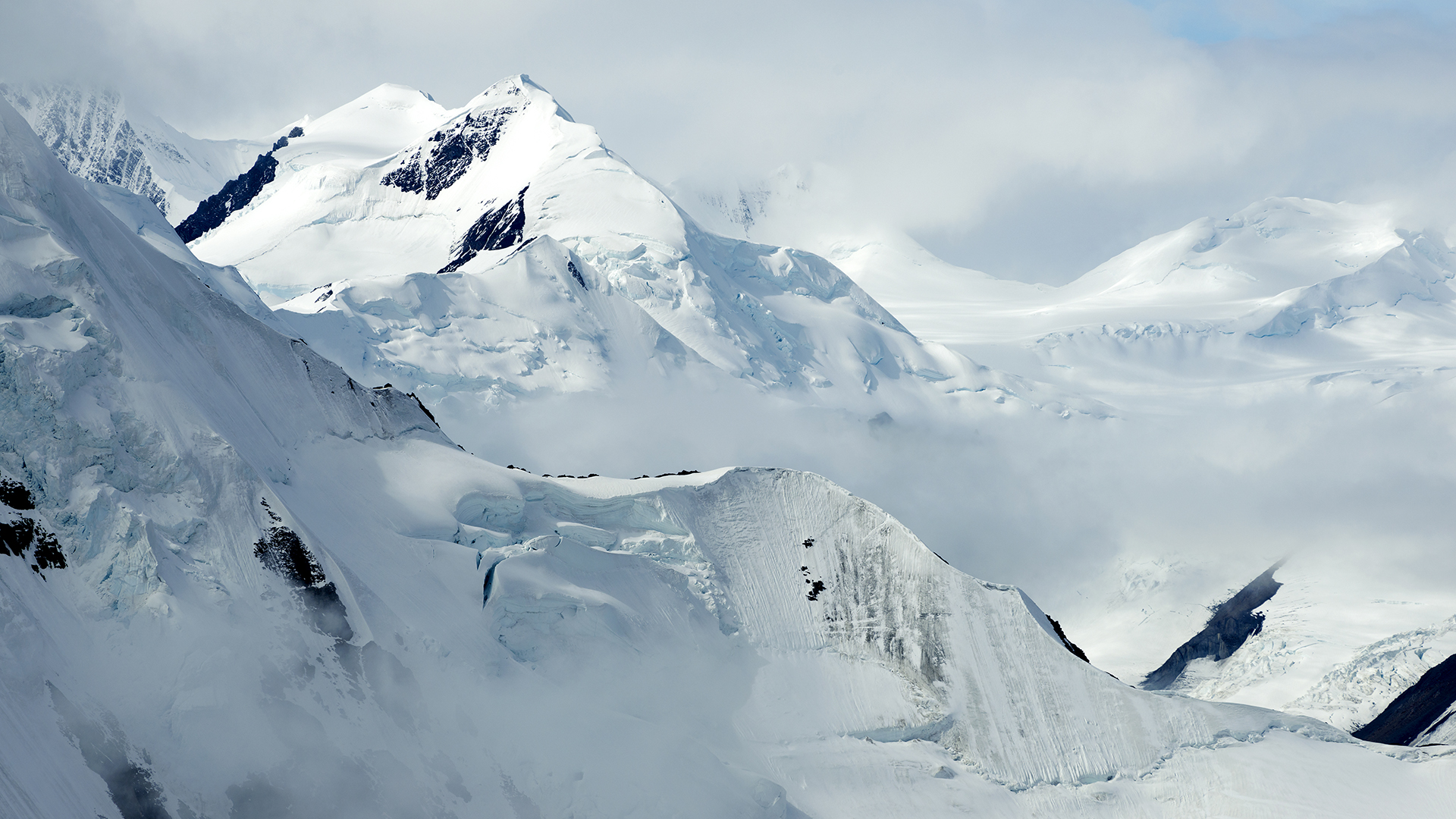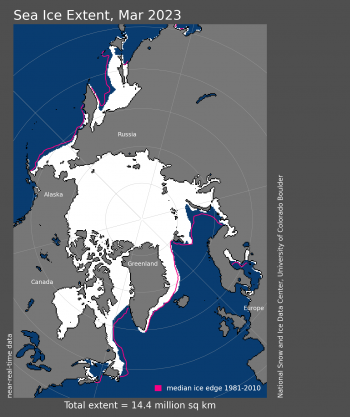New Study: Greenland Ice Sheet Lost One Trillion Tons Since 1985
As reported by The Guardian on January 17, scientists have determined that the Greenland ice sheet has lost 20% more ice than previously estimated. In a new study published in Nature, researchers examined more than 235,000 observations from satellite images to determine the monthly end positions of Greenland’s many glaciers between 1985 to 2022. The data revealed that about 5,000 square kilometers of ice have disappeared from the Greenland ice sheet around the margins since 1985, which is the equivalent of one trillion tons lost. (The Guardian)
Take 1: The finding that the Greenland ice sheet has lost around one trillion tons of ice is highly alarming. Ice sheets are critical because they contain enormous amounts of frozen water. As glaciers and ice thaw, this freshwater is released, potentially contributing to sea level rise and weakening vital ocean currents that regulate the global climate, like the Atlantic Meridional Overturning Circulation. In this study, most of the glaciers were located below sea level, so their runoff did not directly contribute to sea level rise. However, the substantial ice loss could trigger further thawing and push the Greenland ice sheet towards a tipping point, leading to irreversible melting. The ice sheet is already the second-largest contributor to sea-level rise, affecting communities around the world through coastal erosion, saltwater intrusion, habitat loss, and flooding. The Greenland ice sheet is also indicative of the global decline of glaciers, with the average thickness of all glaciers decreasing by 1.3 meters in 2023, according to the World Meteorological Organization. A complete loss of Earth’s glaciers could raise global sea levels by hundreds of feet. Although it has long been known that the Greenland ice sheet is losing mass, this new study provides additional evidence for the pressing need to mitigate global warming. Without drastic action, the risks to the ice sheet and its subsequent consequences could be immense. (Eye on the Arctic, National Snow and Ice Data Center, NBC News, NOAA)
Canada Tests Wastewater Surveillance for Early TB Detection
As reported by Nunatsiaq News on January 17, a team of researchers has been awarded $3.5 million from the Canadian Institutes of Health Research to conduct a five-year study to improve tuberculosis screening programs in Nunavut. The project will involve testing spit, urine, stool, and wastewater from tuberculosis patients and monitoring wastewater from specific locations to detect the bacteria. The research will be conducted under the guidance of the Taima Tuberculosis Steering Committee. (Nunatsiaq News)
Take 2: Tuberculosis and other public health issues are critical concerns in the Canadian North. While the rate of tuberculosis is relatively low for much of the country, outbreaks continue to regularly occur in communities across the Arctic. Indigenous peoples are particularly vulnerable, with the Public Health Agency of Canada finding that the rate of tuberculosis is 290 times higher among Inuit. Several factors contribute to these highly disproportionate impacts. In many Indigenous communities, historic underinvestment and the lack of resources have resulted in insufficient medical infrastructure, hindering the prevention and treatment of illnesses. Housing shortages and high costs of living have also led many to live in shelters and overcrowded conditions, which contribute to outbreaks by facilitating the spread of disease. Access to healthcare is further limited by the remote location of many Arctic settlements, making it difficult for medical services to reach these communities. Therefore, the new research study is vitally important as it could provide a useful mechanism for the early detection of tuberculosis, preventing outbreaks from starting. Wastewater surveillance remains a novel procedure that requires further development, but even a few days of early warning can be critical to the success of disease responses. Although the new project is a step in improving public health, more action is needed to reduce the health gaps between Arctic and non-Arctic communities in Canada. (CBC News, Government of Canada, Public Health Agency of Canada, The Guardian, Water Canada)
Sandia National Laboratories Investigates Ice-albedo Feedback
As reported by earth.com on January 15, a new study published in Nature Scientific Reports found that the Arctic’s ability to reflect sunlight, also known as albedo, has decreased by 20% to 35% over the Arctic summer. The researchers from Sandia National Laboratories analyzed data from GPS satellite radiometers, spanning from 2014 to 2019, to observe the sunlight reflection patterns over the Arctic with unprecedented accuracy and detail. The study remains ongoing, and the scientists encourage further research into the innovative data. (earth.com)
Take 3: The study by Sandia National Laboratories provides critical new insight into the Arctic’s rapid warming and dramatic environmental changes, specifically through sea-ice albedo feedback. The Arctic has an essential role in regulating the global climate by reflecting sunlight back into space and venting excess energy. This reflectivity is known as albedo. While light surfaces like snow and ice have high albedo and reflect more sunlight, darker areas will absorb the sun’s energy and solar heat. As sea ice melts, it exposes more open, dark ocean surfaces that absorb sunlight, increasing temperatures in the region. At the same time, the weathering of the remaining sea ice further reduces the Arctic’s reflectivity through meltwater ponding and other factors. These processes create a vicious feedback loop where melting sea ice leads to less reflectivity and higher temperatures, which causes even more ice to melt. While many previous studies have suggested that sea-ice albedo feedback contributes to the Arctic’s intense warming, the study’s findings that there has been a 20% to 35% decrease in the Arctic’s total reflectivity is harrowing. As global temperatures continue to rise, sea ice melt will likely intensify, further reducing reflectivity and amplifying Arctic warming with serious consequences for the weather and climate around the world. Thus, the new research adds to the level of urgency for immediate climate action to protect the region. (National Snow and Ice Data Center, Norwegian Polar Institute, The Conversation)
UK Prepares for Nordic Response 2024 in Norway
As reported by The Barents Observer on January 14, troops from the UK Commando Force have arrived in Tromsø, Norway, in preparation for NATO’s Nordic Response 2024 exercise, previously named Cold Response. The British soldiers will form part of the 20,000 troops from 14 countries participating in the operation in March. About 100 aircraft and 50 naval vessels will also be involved in the exercise. Some areas of operation will include Alta in northeastern Norway, and significant maritime activity will take place off the coast of Finnmark. (The Barents Observer)
Take 4: NATO’s upcoming exercise in March, Nordic Response 2024, is poised to be one of the alliance’s largest Arctic exercises in recent years. Centered around the northern Nordic region, the exercise is specifically aimed at better integrating Sweden and Finland with other allied forces and strengthening NATO’s Arctic defense. The operation follows rising military tensions and increased aggression from Russia in the region, especially after Finland and Sweden’s decision to join the alliance. These actions include an increasing number of strategic bombers flying close to Norwegian airspace, the inauguration of two new nuclear-powered submarines, and allegations of intentionally allowing a growing number of asylum seekers to cross into Finland. While the NATO exercise will take place within allied territories, Nordic Response differs from previous exercises as some military activity will take place closer to Russia. Despite being a defensive exercise, the operation is a clear signal of NATO’s strong commitment to maintaining security in the High North. As the security situation in the Arctic continues to deteriorate, shows of force and large-scale exercises like Nordic Response will become more prevalent and potentially closer in distance. Thus, to avoid miscommunication and reduce the risk of confrontation, it is essential that Arctic operations remain transparent and that forces in the region continue to strengthen mechanisms for dialogue. (AP News, Carnegie Endowment for International Peace, France 24, Norwegian Armed Forces, The Barents Observer)
Norway Awards Oil and Gas Licenses in the Arctic – Again
As reported by Reuters on January 16, the Norwegian government has awarded 62 new licenses to 24 energy companies to conduct oil and gas exploration in predefined offshore areas. 8 of the licenses are located in the Barents Sea, 25 were issued for the Norwegian Sea, and 29 were awarded for the North Sea. Firms that received stakes in licenses include Equinor, Aker BP, Vaar Energi, Shell, TotalEnergies, and ConocoPhillips. The Norwegian Shelf Directorate estimates that the country will reach peak production in 2025. (Reuters)
Take 5: The awarding of 62 new licenses concludes yet another expansion to the oil and gas industry in Norway, pushing the nation towards some of its highest levels of hydrocarbon extraction in recent years, particularly in the Arctic. The latest round of licensing follows several other controversial environmental decisions by the country, including the permitting of deep-sea mining and the awarding of 47 licenses in 2022, highlighting Norway’s continued commitment to resource production. Yet, the country’s ramp-up of resource exploration comes at a time when the international community is looking to transition away from fossil fuels like oil and natural gas to mitigate climate change. According to the US Energy Information Administration, fossil fuels account for more than 70% of greenhouse gas emissions, contributing to significant global warming. The impacts of rising temperatures are especially severe in the Arctic, where Arctic amplification is warming the region four times faster than the rest of the world. Beyond climate concerns, offshore oil and gas production can also harm the Arctic’s delicate ecosystem through underwater noise pollution, habitat loss, contamination, and other risks. However, despite these concerns and Norway’s assurances on emissions reduction and environmental protection, the awarding of new licenses indicates that the oil and gas industry will likely remain a growing sector for the country, at least in the near term. (BBC, NOAA, UNFCCC, US Energy Information Administration, World Wildlife Fund)





My brother suggested I might like this blog He was totally right This post actually made my day You can not imagine simply how much time I had spent for this info Thanks
Well I sincerely liked studying it. This tip offered by you is very useful for proper planning.
Thanks for discussing your ideas on this blog.
Thank you for your sharing. I am worried that I lack creative ideas. It is your article that makes me full of hope. Thank you.
Thanks for your text.
Thank you, I’ve just been looking for info approximately this topic for a while and yours is the best I’ve came upon so far. But, what about the conclusion? Are you sure concerning the source?
Good day! Thanks for the post!